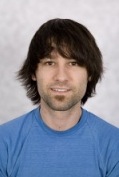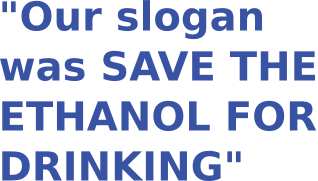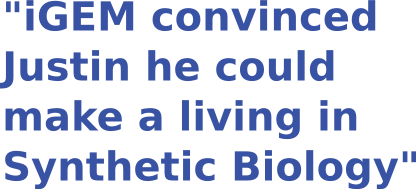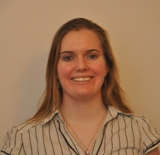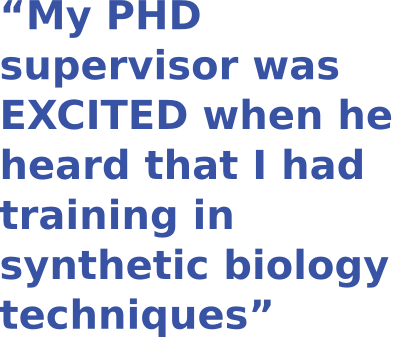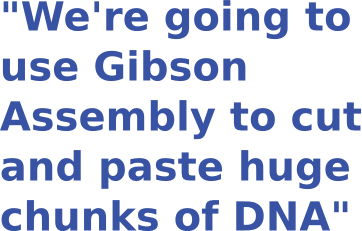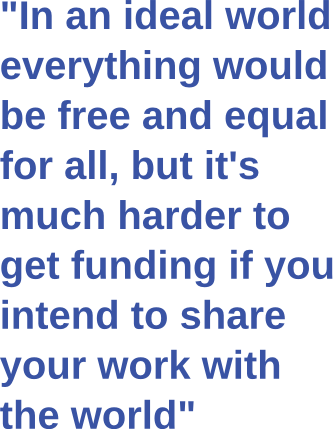Team:Cambridge/Society/interviews
From 2011.igem.org
Contents |
Background
On our online questionnaire, participants were asked if they were willing to be contacted with some further questions about their iGEM experience and their careers. We were pleasantly surprised to see a high proportion or respondents agree to be contacted.
Shuna Gould and Justin Pahara were working in Cambridge and were willing to drop by the lab for a recorded interview. Kim de Mora was in Edinburgh and recorded via skype.
The impact of iGEM – an interview with Justin Pahara
Justin Pahara was first involved in iGEM shortly after finishing his first degree in Immunology and Infection. He met Andrew Hessle, who he describes as an evangelist for Synthetic Biology. Through this meeting Justin was introduced to synthetic biology which not only changed his views, but lead him to cross the globe, pursue a PHD in biotechnology and found several start up companies including one orientated towards catalysing interdisciplinary work in synthetic biology.
In 2007, Justin was part of Andrew Hessle’s Alberta University team as iGEM was brought to Canada for the first time. The team focussed on engineering biobutanol production, as they believed it could be a biofuel superior to bioethanol, hence their slogan “save the ethanol for drinking”. In 2008 Justin was also an iGEM advisor on the 2008 team.
We asked Justin if iGEM changed the kind of people you expected to work with. With some conviction he told us the iGEM most definitely had; he is now a strong advocate of interdisciplinary work having seen the benefits that can come from bringing expertise from artists, businesspeople, and engineers together to push science forward. He stressed that the solution to a problem will often be better when found in conjunction with a team from diverse backgrounds than when limited to colleagues in your own academic circle - a step outside the scientific comfort zone.
Perhaps one of the biggest influences on an alumnus iGEM could ever have is convincing them that they could make a living in synthetic biology. This is what iGEM has done for Justin Pahara. His company Synbiota, founded with colleagues who work in bioinformatics and software development, will provide tools and services to enable and equip scientists, particularly those in synthetic biology, with a grand aim of making a web of information and idea sharing which they hope will improve the productivity of the field from grass-roots school projects to field leaders.
We probed him to find out how much of iGEM had rubbed off on him and his business ventures. He replied that Synbiota is adhering to synthetic biology principles. They agree with abstraction as a valuable process by which to remove unnecessary complexity and strongly support crowd-sourcing of information as an engine with which to power progress. Justin firmly believes that it is only a matter of time until the rest of the world adopts these principles in broader contexts.
Justin claims that he would always have headed into biotechnology to make his name, but that iGEM resulted in a profound change in his ideas about science and engineering. Although he believes he would have realised the benefits of concepts such as abstraction and crowd-sourcing eventually, he feels he has had a head-start on colleagues working in biotech as a direct result of his involvement in iGEM and being introduced to synthetic biology. For Justin, the most important thing he learnt was the parallels that can be drawn between synthetic biology and the software industry as markets.
In particular Justin envisages a future where the cost of DNA synthesis comes down to the point where, like when the personal computer entered peoples homes, making DNA will be not only relatively quick and cheap, but a technology with a rapidly growing user base. In fact he predicts that the design and ‘light tinkering’ of DNA is a field that will literally explode. He paints an inspiring picture one of DNA modification by those in academia, corporations, DIY bio, even junior high school kids will be just chilling out, writing DNA code.
Questions by Cambridge iGEM 2011 Team, Interview by Joe Harvey, Write-up by Matt Jones.
An interview with Kim de Mora
Interview by Matt Jones, Video by Matt Jones.
An interview with Shuna Gould
Shuna gould heard about iGEM in her second year of studying Natural sciences at Cambridge and was attracted partly because of the exciting work that previous Cambridge teams had done. Having done a couple of summer research projects before she was particularly interested in iGEM because of the independent nature of the research.
Shuna is therefore in an excellent position to compare iGEM to other summer research projects. She points out that it is much more challenging, intense and a powerful learning curve. Several of our team, and postgraduates we’ve spoken to agree and we’re sure that throughout iGEM there will be countless other people who recognise that this is no ordinary summer research project.
We heard how iGEM has influenced Shuna’s career not only in terms of providing opportunities within science, but also how she feels ready to make a leap into completely different lines of work after her PHD, thanks to skills at least partly developed during iGEM.
Soon after iGEM Shuna was fortunate to be able to continue her teams work with two of the principal investigators involved in supervising her team, Jim Haseloff and Jim Ajioka from Cambridge University. iGEM has also impacted on her path since then, and she is now embarking on a PHD in which she plans to use techniques she was first taught during iGEM.
One key influence for Shuna was that iGEM opened her mind to PHD topics that she had not previously considered and that her chosen PHD supervisor was excited when he heard that she had had training in synthetic biology techniques. Furthermore, together they have discussed in depth how Gibson assembly can be used to aid her in reliably cutting and pasting genomes during her project which will be dealing with much larger lengths of DNA than she used during her bacterial plasmid work in iGEM. This is at least one example of a situation where techniques taught in iGEM are infiltrating into more in-depth research like a PHD thesis as iGEM students progress in academia.
It is fascinating to hear how iGEM has affected peoples professional lives, but we wanted to know how synthetic biology has affected the mindsets of iGEM alumni. Shuna said she was initially sceptical about the use of abstraction in biology, as her biochemistry training taught her that all biological systems are wonderfully complex. However, through iGEM she learnt that engineering principles allow a fresh, common sense approach to biology, and she also commented on the power of being able to take components out of systems in order to explore their properties and that being encouraged to ‘play around’ with genes is not only exciting but often a very useful thought process. Moreover, iGEM pushed Shuna to get to grips with modelling and to explore the use of computational tools in her research, which will undoubtedly be useful in the future.
When we asked Shuna about the open source nature of iGEM we unearthed a conflict. Shuna said that she loves the open source ethos of iGEM, the fact that her team made genes for bacterial pigments that are now widely available for anyone else to use is fantastic, she told us. However, she did say that if something profitable were to come from her PHD research, she would look into making money from it, and recognises that research in an open source world lacks that reinvestment of profits that commercialised research has.
Finally we asked about the impact of synthetic biology in the wider world. Shuna told us that she is most excited about what synthetic biology can do for medicine, mentioning the ease with which microorganisms can synthesise drugs like antibiotics which are otherwise require a complex and costly chemical synthesis.
Interview by Catriona McMurran, Write-up by Matt Jones
 "
"


